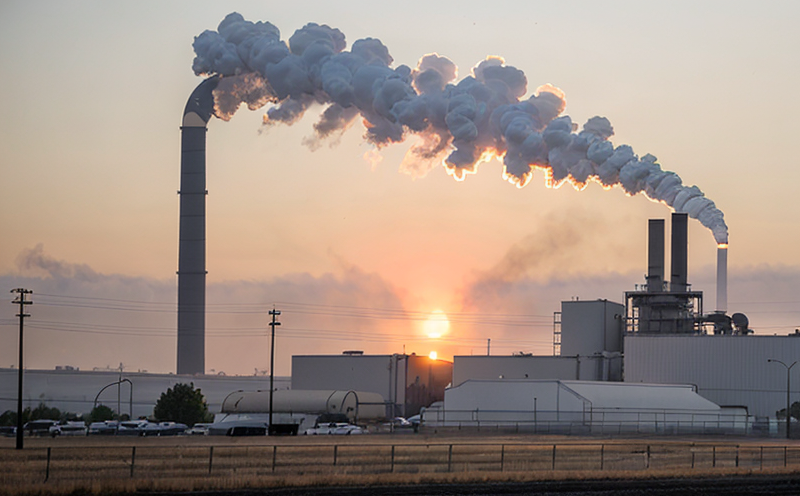ISO 23428 Arsenic and Cadmium Testing in Industrial Emissions
The industrial sector is a crucial part of our global economy, but it also faces significant challenges related to environmental protection. ISO 23428 specifies the procedure for determining total concentrations of arsenic (As) and cadmium (Cd) in gaseous emissions from industrial processes.
Industries such as metal smelting, coal combustion, waste incineration, and electronics manufacturing are prime candidates for this type of testing. These sectors release volatile pollutants into the atmosphere during their operations. Accurate measurement is essential to ensure compliance with environmental regulations and protect public health.
The testing procedure outlined in ISO 23428 involves several steps: sampling, sample preparation, analysis using suitable analytical techniques like atomic absorption spectrophotometry (AAS) or inductively coupled plasma mass spectrometry (ICP-MS), and reporting the results. The acceptable limits for arsenic and cadmium emissions are strictly defined by international standards to minimize their environmental impact.
Understanding the significance of this testing is crucial for industries that are subject to stringent regulatory requirements. By adhering to these standards, companies can demonstrate their commitment to sustainable practices and avoid potential legal and financial penalties. For quality managers and compliance officers in industrial settings, ISO 23428 offers a clear framework for ensuring emissions fall within acceptable limits.
For R&D engineers, this service provides valuable insights into the effectiveness of new emission control technologies. By testing their prototypes against these standards, they can fine-tune their designs to achieve optimal performance while meeting regulatory demands. Similarly, procurement professionals will find ISO 23428 invaluable when selecting suppliers who adhere to high environmental standards.
The importance of this service extends beyond just compliance; it plays a pivotal role in enhancing public health and environmental safety. By reducing the presence of harmful elements like arsenic and cadmium in industrial emissions, we contribute to cleaner air for communities around these facilities.
Why It Matters
The importance of ISO 23428 cannot be overstated. Arsenic and cadmium are toxic elements that can pose serious risks to human health when they enter the environment through industrial emissions. Both substances are known carcinogens, which means they have been classified as substances capable of causing cancer in humans.
- Exposure to arsenic has been linked to various health issues including skin lesions, cardiovascular diseases, and cancers of the bladder, liver, lungs, and prostate.
- Cadmium exposure is associated with kidney damage, bone diseases like osteoporosis, and certain types of cancer.
Environmental pollution caused by these elements can lead to widespread contamination of soil, water bodies, and air. This not only affects the immediate surroundings but also has far-reaching consequences for ecosystems and biodiversity.
The testing procedure described in ISO 23428 is designed to quantify these pollutants at levels that are harmful to human health and the environment. By providing precise measurements, this service helps industrial facilities identify areas where improvements can be made in their emission control systems.
Customer Impact and Satisfaction
Implementing ISO 23428 Arsenic and Cadmium Testing in Industrial Emissions offers several benefits to customers. Firstly, it ensures that industrial processes are compliant with international standards, thereby reducing the risk of legal action or fines from regulatory bodies.
Secondly, by adhering to these stringent testing protocols, companies can enhance their reputation as environmentally responsible entities. This is particularly important in sectors where public perception plays a significant role in corporate success. For instance, manufacturers and processors are increasingly under pressure to demonstrate their commitment to sustainability.
Thirdly, this service helps customers achieve long-term cost savings by preventing costly mistakes that could arise from non-compliance with environmental regulations. By proactively managing emissions through regular testing, businesses can avoid unexpected disruptions or shutdowns caused by regulatory violations.
Use Cases and Application Examples
| Industry Sector | Specific Application | Emission Source |
|---|---|---|
| Metal Smelting | Monitoring emissions from metal reduction processes. | Flue gases from smelting furnaces. |
| Coal Combustion | Evaluating the impact of coal-fired power plants on air quality. | Stack emissions from power generation units. |
| Waste Incineration | Assessing the release of pollutants during waste disposal processes. | Flue gases from incinerators handling hazardous materials. |
| Electronics Manufacturing | Evaluating emissions from soldering and plating operations. | Ventilation air streams in clean rooms. |
In each of these scenarios, the testing process plays a critical role. For example, in metal smelting, the test results can help identify whether the reduction processes are releasing arsenic and cadmium at levels that could harm nearby communities or the environment. In coal combustion applications, continuous monitoring ensures that emissions do not exceed safe limits set by environmental authorities.
- For waste incineration facilities, accurate testing helps determine if the process is effectively managing toxic elements like arsenic and cadmium before they are released into the atmosphere.
- In electronics manufacturing, periodic testing can ensure that emissions from various stages of production do not compromise air quality in nearby areas.





